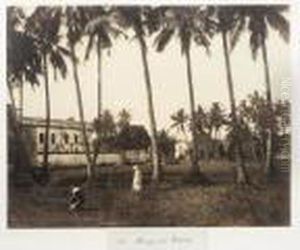Frederick Fiebig Paintings
Frederick Fiebig was a painter, lithographer, and one of the early practitioners of photography, particularly known for his work in the mid-19th century. Born in 1803, Fiebig's background and early life are not extensively documented, but his contributions to the development of early photography and his extensive travels have made him a figure of interest in art historical studies. His exact date of death remains unknown, which adds an element of mystery to his biography.
Fiebig's work is significant for its pioneering use of photography in documenting landscapes, cityscapes, and cultural practices across various countries, notably in India, Ceylon (now Sri Lanka), and possibly other parts of Asia during the 1850s. He was among the first to capture images of these regions, offering invaluable insights into the architecture, landscapes, and societies during a period of significant change and colonization.
In the early 1850s, Fiebig embraced the calotype process, an early photographic technique that allowed for paper negatives and multiple prints to be made from a single negative. This was a relatively new technology at the time, and Fiebig was innovative in his approach, adapting and experimenting with the process to capture the essence of the Asian subcontinent's diverse cultures and majestic sceneries. His collections, including a notable series on India from 1851, are among the earliest photographic records of the country and provide a rare visual history of the era.
Fiebig's photographs were not only important for their historical and cultural documentation but also for their technical achievements in the early years of photography. Despite facing the challenges of long exposure times and the cumbersome equipment of the day, his work exhibits a keen eye for composition and detail, characteristics that have earned him a place in the annals of photographic history.
While Fiebig's life and career might be shrouded in some obscurity, his surviving works are preserved in several institutions around the world, offering a glimpse into the past and the pioneering spirit of early photographers. His photographs continue to be studied and appreciated for their historical value and their contribution to the development of photography as an art form. However, the lack of comprehensive records on his life and the uncertain circumstances of his death mean that much about Frederick Fiebig remains to be discovered.
